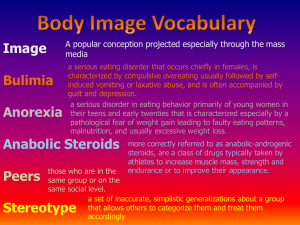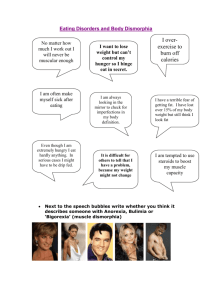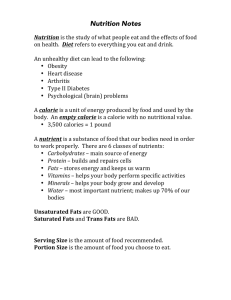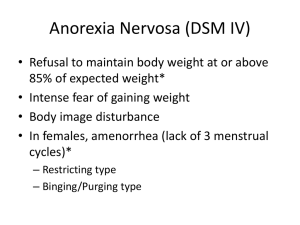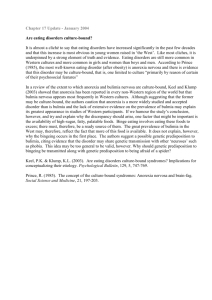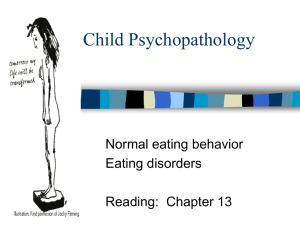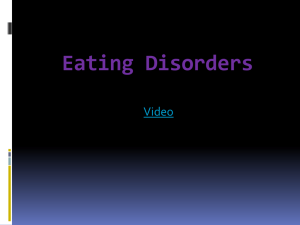Eating Disorders
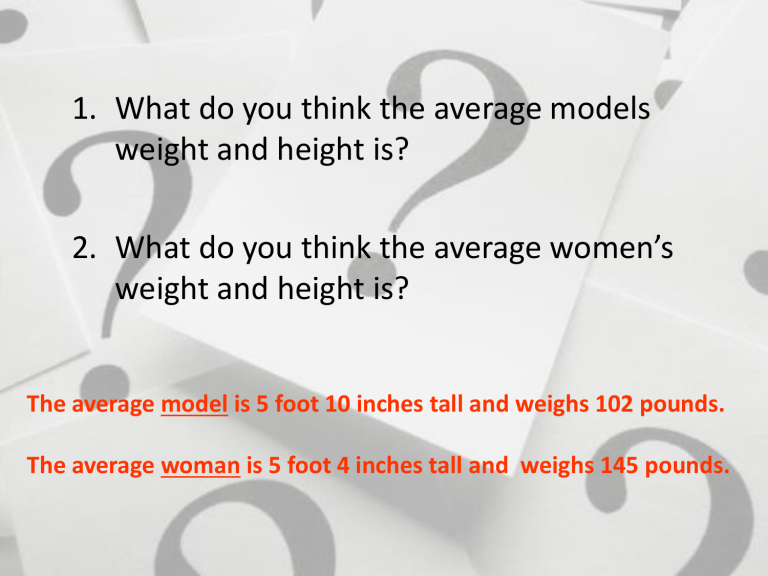
1. What do you think the average models weight and height is?
2. What do you think the average women’s weight and height is?
The average model is 5 foot 10 inches tall and weighs 102 pounds.
The average woman is 5 foot 4 inches tall and weighs 145 pounds.
Eating Disorders
Unit 4 Nutrition
Video
Dove
Evolution
What is an eating disorder?
A serious disturbance in eating behavior, such as extreme and unhealthy reduction of food or severe overeating.
Body Dysmorphic Disorder
Psychological disorder in which a person becomes obsessed with defects in their appearance.
Anorexia Nervosa
• People who are obsessed with controlling their eating; they achieve their weight through starvation.
Symptoms of Anorexia:
• Losing a lot of weight.
• Hair becomes brittle and falls out.
• An obsessive desire to be thinner.
Consequences of Anorexia Nervosa
• Reduction of bone density (osteoporosis), which results in dry, brittle bones.
• Muscle loss and weakness.
• Severe dehydration, which can result in kidney failure.
Bulimia
• Bulimia nervosa is characterized by cycles of bingeing and purging.
Symptoms of Bulimia
• Repeated episodes of bingeing and purging.
• Feeling out of control while eating.
• Vomiting, using laxatives, diet pills or diuretics, exercising excessively, frequent dieting and skipping meals to rid the body of food.
Consequences of Bulimia
• Inflammation and possible rupture of the esophagus from frequent vomiting.
• Tooth decay and staining from stomach acids released during frequent vomiting.
• Chronic irregular bowel movements and constipation as a result of laxative abuse.
Binge Eating Disorder (BED)
Individuals with
Binge Eating
Disorder, eat excessive amounts of food at one time.
Symptoms of BED
• Eating large amounts of food frequently and in one sitting and feeling out of control.
• Eating quickly and in secret.
• Feeling guilty and ashamed of their binges.
Consequences of BED
• High blood pressure.
• High cholesterol levels.
• Heart disease.
• Type II diabetes.
Treatment
Treatment usually includes working with a team of specialists:
• Therapist
• Nutritionist
• Doctor or nurse practitioner.
Prevention
• Keep in mind your personal positive qualities and talents.
• Build up your selfimage, body-image, and self-esteem.
• Understand there are no good or bad foods.
What you can do as a friend:
• Be supportive
• Talk to them in a positive manner.
• Don’t talk down about yourself.
Be a Friend… Be Aware!
Steroid Use
Unit 4 Nutrition
STERoiDS
Anabolic steroids are artificial forms of the hormone testosterone, a hormone that is involved in muscle development.
Why people choose to use Steroids:
• Doctors will actually prescribe steroids for people with muscular disorders.
• Other people use them illegally to improve their athletic performance or change their appearance.
Signs of steroid use:
Physical Changes Personality/Social Changes:
• Rapid or progressive weight gain
• Increased muscle size (sudden or progressive)
• Jaundice or yellowing of the skin; this signals liver damage
• Small red or purplish acne, including breakouts on the shoulders and back
• Extreme mood swings
• Increased aggression or irritability
• Paranoia - extreme feelings of mistrust or fear
• Begins receiving more packages in the mail
Steroid use gone wrong:
